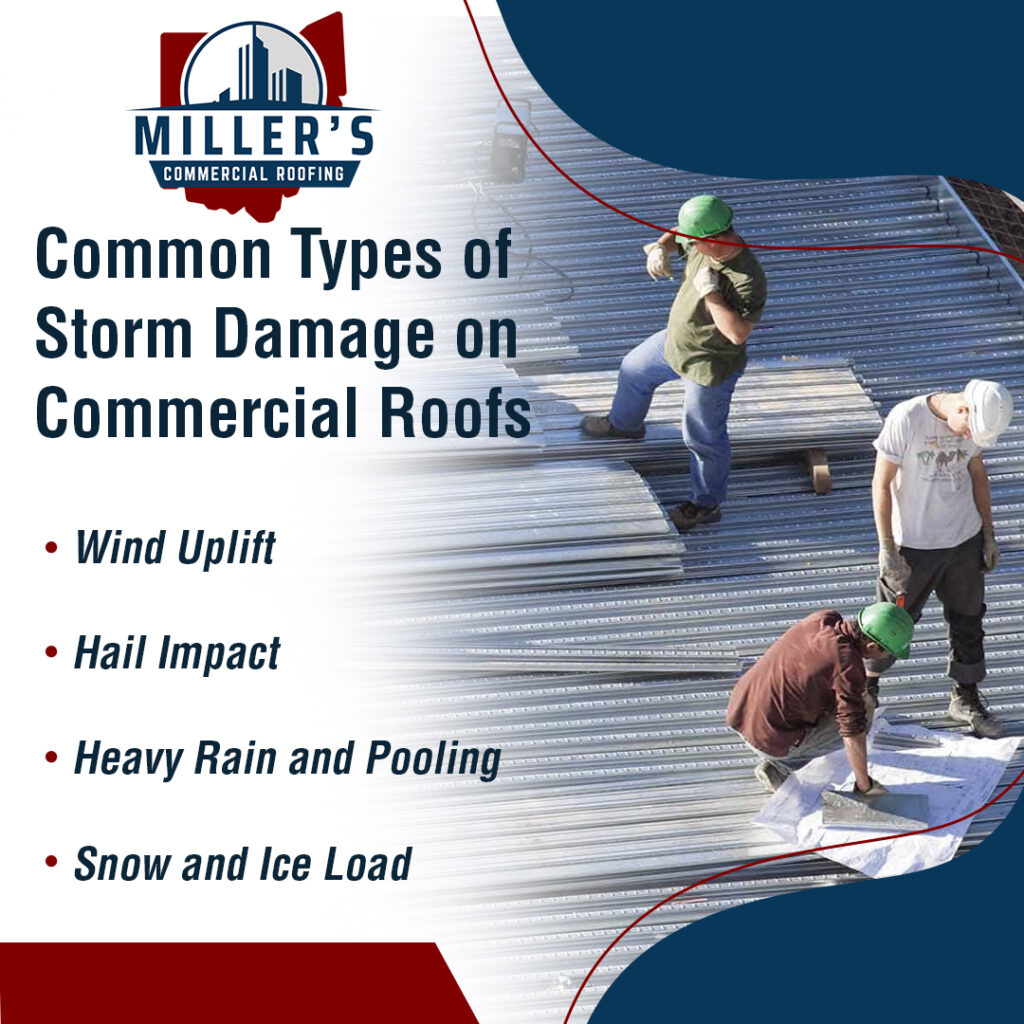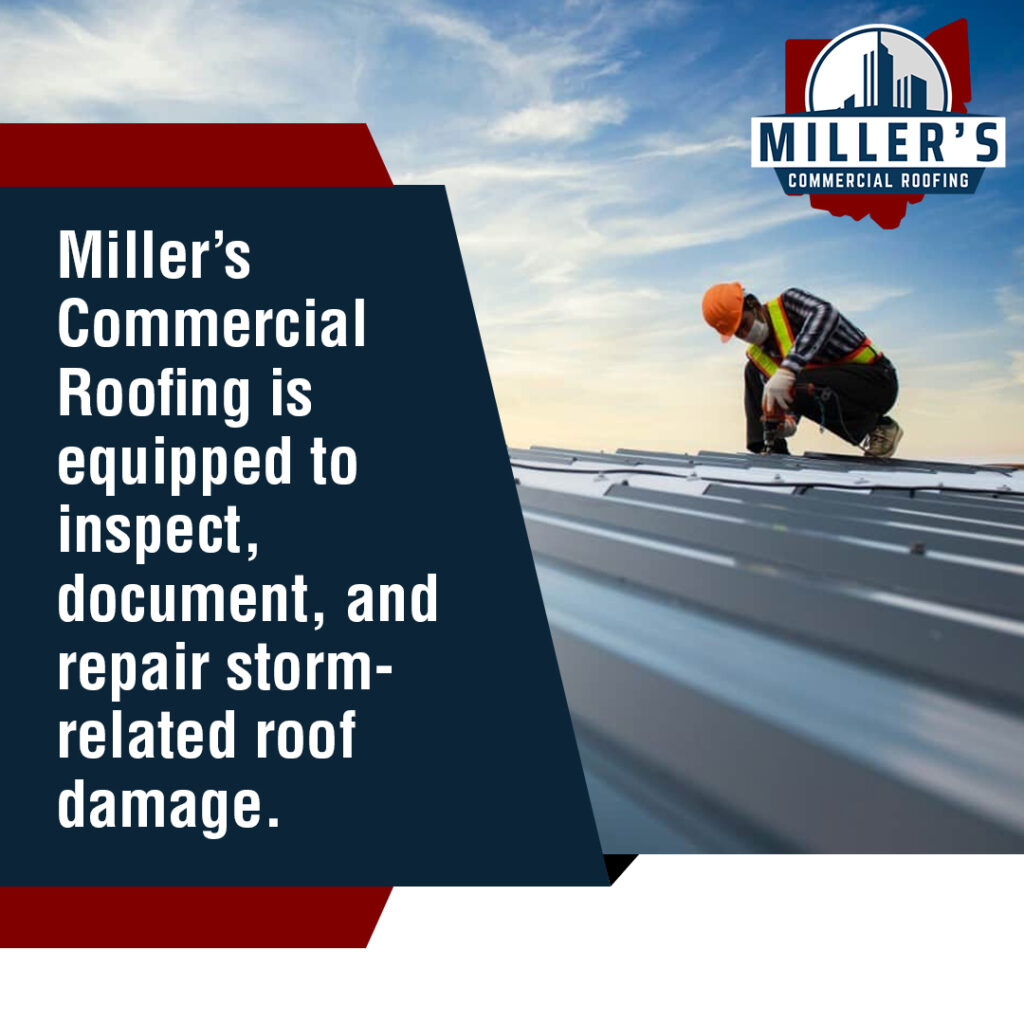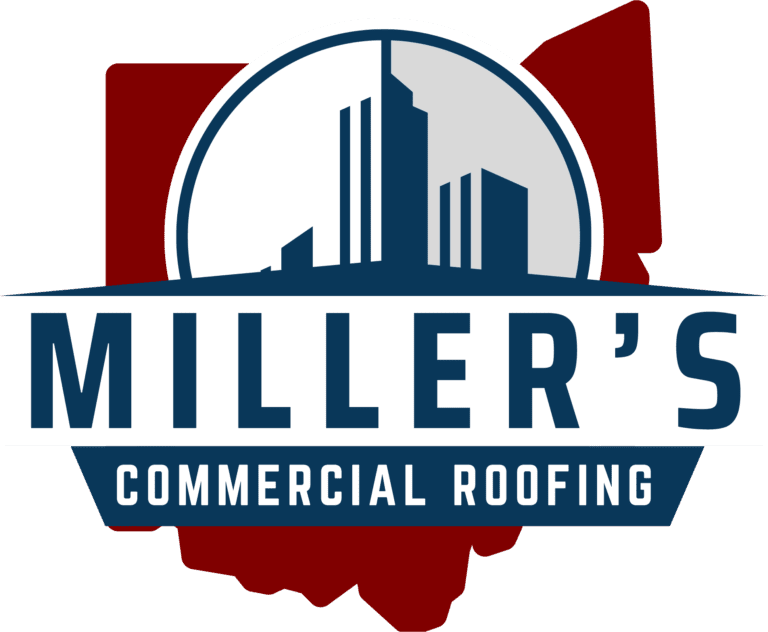Taking prompt action when a storm damages your commercial roof can avoid more expensive repairs that can occur later on. Delays can lead to structural issues, leaks, and business disruption. Storms in Baltic, OH, and the surrounding areas bring high winds, heavy rain, and hail. These conditions can damage roof membranes, dislodge flashing, and cause pooling that weakens roof decks. Commercial buildings are vulnerable due to their wide surface areas and flat or low-slope roofing systems.
Calling your roofing company first ensures you’re working with professionals familiar with your system and regional weather patterns. As a local commercial roof repair contractor, Miller’s Commercial Roofing has the experience and tools to assess damage correctly and recommend the right solution. We also document storm impact clearly so that it is useful for both repairs and insurance claims. If you’re responsible for a warehouse, retail building, manufacturing site, or office space, a prompt call to our commercial roof repair service can prevent interruptions and reduce long-term costs.
Common Types of Storms That Impact Commercial Roofs in Baltic, OH
Storm damage weakens the roof’s protective barrier, which increases the risk of leaks, insulation failure, and costly structural issues. Commercial buildings with flat roofs and aging materials are particularly at risk.
Damage may not be obvious right away. Small punctures or loose flashing may go unnoticed until they cause larger issues. After a storm, professional inspection by a commercial roof repair contractor can identify damage early and reduce long-term repair costs.

Wind and Uplift
High winds loosen roofing materials and cause uplift, especially on flat and low-slope roofs. Edge flashing, ballast, and membrane seams are common failure points. Winds as low as 45 mph can shift loose sections of single-ply roofing systems. Single-ply systems rely heavily on proper installation and secure perimeter attachment.
Wind uplift forces tend to be strongest at the edges and corners of a roof. Torn seams and dislodged flashing often lead to water infiltration. Once wind gets under the membrane, it creates a vacuum effect that lifts materials. Calling a commercial roof repair service quickly after windstorms helps stop minor issues from becoming structural problems.
Hail Damage
Hailstones puncture membranes, dent flashing, and weaken roof coatings. Even small hail can cause damage to commercial roofing systems over time. A 1″ hailstone can crack roofing membranes and damage underlying insulation. Larger hailstones can shatter skylights or leave exposed areas vulnerable to leaks. After a hailstorm, a licensed commercial roof repair contractor should document and assess the impact.
Heavy Rain and Flooding
Prolonged rain causes pooling and drainage failure on flat roofs, which leads to water damage and leaks. Blocked scuppers, drains, or gutters increase the risk.
Rainwater that doesn’t flow off properly can infiltrate seams and saturate insulation. This can lead to ceiling stains, indoor humidity, and weakened structural support. Inadequate drainage is one of the most common problems reported by commercial roof repair contractors in Baltic, OH. Frequent cleaning and prompt repair of drainage systems help reduce this risk.
Snow and Ice Load
Snow and ice add weight to the roof and cause freeze-thaw damage to seams and membranes. Flat roofs are especially vulnerable to ponding and cracking in cold weather.
According to the Ohio Building Code, roofs must handle 20–30 pounds per square foot (psf) of snow load. Wet snow weighs more than dry snow and builds up quickly. Ice dams form at the edges, forcing water beneath the membrane layers. Commercial roof repair contractors can check for stress points and clear accumulated snow safely without damaging the surface.
Typical Signs of Damage After a Storm
Visible roof damage, leaks, and loose materials are key signs your commercial roof may need repairs after a storm. These issues often lead to larger structural or interior problems if not addressed promptly.
Membrane Tears or Punctures
Tears in the roofing membrane allow water to seep into the insulation and deck. They often appear near seams, flashing, or equipment mounts. Windborne debris, hail, and falling branches can puncture single-ply or built-up roofing systems.
Even small tears can create entry points for water, which can weaken the roof structure over time. Commercial roof leaks mostly begin at membrane seams or punctures. A quick response from a commercial roof repair contractor prevents further damage and water-related mold growth.
Water Intrusion or Pooling
Standing water is a sign of drainage failure and may point to insulation or membrane damage. It’s most common on flat or low-slope roofs. After heavy rain or snowmelt, water should drain off the roof within 48 hours. If it remains, it adds pressure to the membrane and can enter through weakened areas.
Pooling also attracts algae and causes premature deterioration. In Baltic’s freeze-thaw cycles, standing water may expand and crack the roofing surface. Prompt roof repair helps protect insulation and improve drainage function.
Loose Flashing or Debris
Displaced flashing or storm debris signals possible damage to seams, vents, or rooftop units. Loose materials often indicate wind uplift or impact. Flashing is installed at edges, penetrations, and junctions to keep water out. If flashing is loose or bent, the roof becomes vulnerable to leaks during the next storm.
In Holmes and Tuscarawas counties, wind gusts commonly exceed 50 mph, which can dislodge metal panels or fasteners. After such events, commercial roof repair services should inspect these areas to restore sealing and prevent moisture intrusion.
Why Timely Action Matters
Delaying storm damage repairs can lead to higher costs, equipment loss, and insurance complications. Acting quickly limits the impact on your business operations and protects the long-term condition of your commercial roof. Waiting too long to contact a commercial roof repair contractor may mean extended exposure to the elements and slower response times. Below are the key risks of delaying action after a storm.
Risks of Delayed Response
Ignoring storm-related roof damage can turn minor issues into major problems. Leaks often spread through insulation and decking before signs appear inside the building. Storm damage tends to worsen over time, especially when water enters through punctures or loose flashing. The longer the delay, the greater the likelihood of mold growth, insulation saturation, and roof deck deterioration.
Escalating Repair Costs
Small issues left unchecked often require more invasive and expensive roof repairs later. Timely repairs when the issues are relatively small are faster, less disruptive, and more affordable.
What starts as a small membrane tear may eventually require full replacement of the roofing system. Emergency work is also more expensive than scheduled commercial roof repairs. Calling a contractor promptly avoids rush charges and business interruption.
Risk to Inventory or Equipment
Leaks and humidity from roof damage can ruin stored goods and critical equipment in warehouses, offices, and manufacturing spaces. Electronics, packaged products, and sensitive materials are often located directly below roofing systems. Once water enters the building, cleanup costs can multiply. Moisture also increases the risk of corrosion in HVAC units and electrical systems. Protecting inventory with timely commercial roof repairs limits loss and downtime.
Structural Complications
Unchecked water intrusion can weaken the roof deck, insulation, and framing over time. This can affect safety, load-bearing strength, and indoor air quality. Flat commercial roofs are vulnerable to long-term water saturation. Over time, this can cause sagging, rot, or even structural failure.
Repairs that would have cost a few hundred dollars may balloon into thousands in structural restoration if left untreated. Commercial roof repair contractors can identify these risks during post-storm inspections.
Insurance Deadlines and Documentation Requirements
Most insurance providers require damage to be reported within a short timeframe after a storm. Missing deadlines can reduce or void coverage.
In Ohio, policyholders often have 30 to 60 days to file storm damage claims, depending on the insurer. Waiting too long to involve a commercial roof repair contractor may limit the ability to prove that the damage was storm-related. Documenting the condition with photos and a repair estimate shortly after the event supports a smoother claim process and faster resolution.

What a Commercial Roof Repair Contractor Brings to the Table
A commercial roof repair contractor provides the tools, knowledge, and services needed to restore your roof quickly and accurately. From emergency patching to full replacement planning, professionals offer support tailored to the demands of commercial buildings.
Baltic, OH, businesses face unique challenges when it comes to flat or low-slope roofs. Working with experienced commercial roof repair contractors ensures faster recovery, better documentation, and long-term protection. Here’s what a reliable contractor like Miller’s Commercial Roofing brings to your site after a storm.
Damage Assessment Tailored to Flat or Low-Slope Roofs
Commercial contractors understand how storm damage affects flat and low-slope roofing systems. At Miller’s Commercial Roofing, we inspect key areas like drainage points, seams, and mechanical penetrations.
Unlike steep-slope residential roofs, flat systems often hide damage beneath membrane layers or trapped moisture. Our contractors are trained in commercial roof repair services and use modern tools to locate damage not visible on the surface. This level of detail avoids underestimating roof repair needs and prevents future leaks.
Temporary Protection (Tarping, Patching)
Immediate protective measures prevent further damage while permanent repairs are scheduled. These include tarping over compromised areas and patching torn membranes.
Fast response limits water infiltration, especially when heavy rain follows a storm. At Miller’s Commercial Roofing, our contractors often carry emergency materials that match EPDM, TPO, or PVC systems commonly used in commercial buildings. Temporary repairs buy time to develop a full repair plan without exposing inventory or interiors to more harm.
Full-Service Repair or Replacement Planning
At Miller’s Commercial Roofing, we provide a detailed roof repair or replacement plan based on the type and extent of storm damage. This includes timelines, material selection, cost estimates, and coordination with building operations.
If repairs are minor, service may be completed within days. In cases of widespread damage, our contractors help determine whether a roof replacement is more cost-effective. Either way, working with a contractor experienced in commercial roof repairs gives you a clear path forward, without unnecessary delays.
Assistance with Insurance Reporting
A qualified contractor can help document damage and submit the necessary materials for your insurance claim. This includes detailed inspection reports, photographs, and repair estimates. Insurance adjusters rely on clear, dated evidence to validate storm claims. Contractors familiar with commercial roof repair services often coordinate directly with insurers, reducing your administrative burden. Timely documentation also supports faster claims approval and payment.
Why Local Expertise Matters
Working with a company that knows the region improves both short-term repairs and long-term results. Weather conditions in Northeast Ohio are unique. Flat and low-slope commercial roofs need tailored attention to deal with hail, wind, snow, and ice. Local knowledge plays a direct role in how damage is assessed and repaired.
Familiarity with Weather Patterns in Northeast Ohio
Local contractors understand the common weather threats in your area. This includes freeze-thaw cycles, high winds, hail, and heavy snow. In the Baltic and the surrounding counties, storms tend to peak during spring and late fall. Knowing when and how damage typically occurs helps contractors anticipate weak points in flat roofing systems. This knowledge improves inspection accuracy and guides repair priorities.
Knowledge of Local Building Codes
Roofing professionals stay current on code requirements specific to commercial buildings in Ohio. This prevents delays in permitting or inspections.
Local codes govern slope requirements, drainage systems, materials allowed, and fastening methods. If repairs or replacements don’t meet these standards, you may face rework or fines. A licensed local commercial roof repair contractor will know what’s required for your building type and location.
Faster Response Time After Storm Events
A nearby team can get to your site more quickly when time matters. This reduces exposure to further water damage or material deterioration.
Baltic businesses rely on rapid service after a storm. A local contractor can begin assessments within 24 hours. Some may offer same-day emergency tarping or patching. Faster response times reduce the likelihood of interior damage and allow business operations to resume sooner.
Ongoing Support for Maintenance and Inspection
A local contractor is more likely to offer regular inspection plans and follow-up services. This adds long-term value beyond a one-time repair. Routine roof inspections can catch minor issues before they grow into major problems. This kind of continued support is useful in areas with frequent storms or harsh winters, as seen throughout Tuscarawas and Holmes counties.
Why Businesses in Baltic, OH Choose Miller’s Commercial Roofing
Miller’s Commercial Roofing offers reliable service tailored to the unique needs of businesses in Baltic, OH, and nearby areas. We provide quick response times, especially after severe storms, minimizing damage and downtime.
Reliable Response After Local Storms
Fast and effective storm damage response protects your business assets and prevents further roof deterioration. Miller’s Commercial Roofing understands the weather patterns in Northeast Ohio and prioritizes emergency repairs and damage assessments after storms.
We can deploy teams quickly, reducing wait times for urgent commercial roof repairs. Our experience with common regional storm issues, such as hail and heavy winds, helps us evaluate the damage accurately.
Focused on Commercial Roof Repair Services
Miller’s Commercial Roofing specializes exclusively in commercial roof repair, offering skilled technicians and industry-specific materials. From membrane tears to flashing issues, we handle a wide range of commercial roofing problems.
We provide full-service repair and replacement planning, including temporary protections like tarping. This keeps your building secure while permanent solutions are arranged. Our expertise helps avoid costly mistakes often made by general contractors unfamiliar with commercial roofing systems.
Long-Term Support and Follow-Up Options
Beyond immediate repairs, Miller’s Commercial Roofing offers ongoing maintenance and inspection services. These services help prevent future storm damage and maintain warranty compliance.
Regular checkups and prompt repairs reduce the likelihood of expensive emergency work. Our commitment to long-term support helps business owners maintain roof integrity and extend service life.
Ready for a Roof Inspection After the Storm?
After a storm, scheduling a prompt roof inspection is essential to protect your commercial property. Early detection of damage avoids costly repairs and prevents moisture-related problems that can affect your building’s structure and operations.
At Miller’s Commercial Roofing in Baltic, OH, we offer expert commercial roof repair services backed by local knowledge and a fast response. Our professional inspections identify issues caused by wind, hail, rain, or ice, providing you with clear roof repair options.
Don’t wait for minor damage to become a major problem. Whether you need an inspection, emergency repair, or long-term maintenance, Miller’s Commercial Roofing is ready to respond. Our experienced team handles commercial roof repair services across Baltic, OH, and surrounding areas with speed and precision. Call us at (330) 491-6087 or email at peter@millerscommercialroofing.com. Schedule your inspection today and protect your building from further storm damage.


